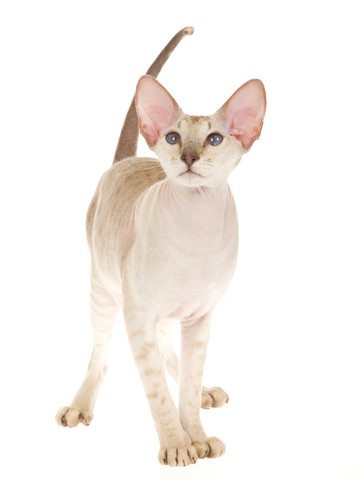Type the name of the breed you're looking for below
[wpdreams_ajaxsearchlite] Don't see the breed your're looking for? Click here and let us know!
Breed Characteristics
1 paw - breed exhibits the least amount of this characteristic
5 paws - breed exhibits most amount of this characteristic
Peterbald
| Origin And History | The Peterbald breed was created during the latter half of 1994 in St. Petersburg, Russia, the result of an experimental mating of a Don Hairless (also known as Don Sphynx, Donskoy or Donsky) male named Afinogen Myth and an Oriental Shorthair female World Champion named Radma von Jagerhov, by Russian felinologist Olga S. Mironova. The first two litters produced four Peterbald kittens: Mandarin iz Murino, Muscat iz Murino, Nezhenka iz Murino and Nocturne iz Murino. These four Peterbalds were the founders of the breed. In 1996, the breed was adopted in the Russian Selectional Feline Federation (SFF) and given a standard and an abbreviation (PBD). In 1997 it was adopted in The International Cat Association (TICA) with the abbreviation PD, and in 2003 in the World Cat Federation (WCF) with the abbreviation PBD. Other used handles of the breed are PTB, PD and PSX. These days the breed develops in the direction of modern Oriental and Siamese types, that is to say a long muzzle, large set-apart ears, flat cheekbones, and an elegant body on long legs. Therefore, all standards for this breed encourage mating with Oriental and Siamese cats and semi-longhair variations of those (such as Balinese and Javanese). The Balinese and Javanese were eliminated from the acceptable outcross list in 2005. The Peterbald was accepted for Championship class competition, effective May 1, 2009, in the American Cat Fanciers Association (ACFA) in August 2008. Effective May 2008, TICA recognizes the "brush coat" Peterbald for Championship competition. |
| Personality | Peterbalds are sweet-tempered, affectionate, peaceful, curious, smart, and energetic. They are medium vocal and tend to follow their owners and always be with them. Peterbalds typically live in harmony with other cats and pets, and also with children. |
Physical Attributes
| Appearance | Peterbalds have an elegantly slim graceful and muscular build. They have a narrow and long head with a straight profile, almond-shaped eyes, wedge-shaped muzzle, and big set-apart ears. They have a long whip-like tail, webbed feet and oval paws that allow them to grasp objects and open levered doorknobs. They are somewhat similar in appearance to Oriental Shorthair cats. They have a hair-losing gene and can be born bald, flocked, velour, brush, or with a straight coat. Those born with hair, except the straight-coats, can lose their hair over time. The Peterbald comes in all colours and markings. |
| Health | The chance of health issues for this cat breed is high. More than 50% of older Peterbald Cats have developed some sort of health condition at one point In their lifetime. Health issues are common among domesticated animals. This cat breed may be susceptible to Vomiting, Fleas, and Feline Lower Urinary Tract Disease. Allergic reactions are not common, but may occur in people with cat allergies that come near the Peterbald Cat breed. |



